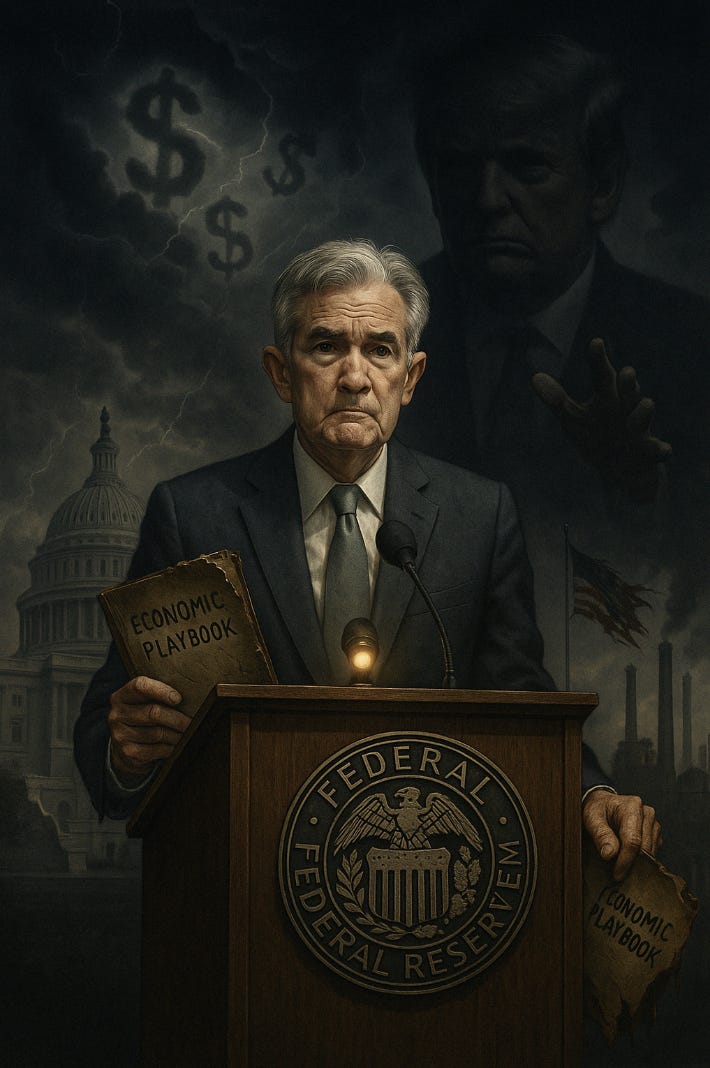The Stagflation Trap: Trump’s Tariff Regime Broke the Fed’s Compass
As Jerome Powell warns of historic economic peril, Trump escalates his war on institutional independence, gutting trade norms, bypassing Congress, and eyeing control of the Fed itself.
When Jerome Powell warns that “there isn’t a modern experience” to draw from in responding to Trump’s trade war, he isn’t being coy, he’s waving a red flag over an unprecedented economic and constitutional crisis. What we’re witnessing is not simply poor policy. It’s an attempt to remake the U.S. economy by executive fiat, with Trump bypassing Congress, rewriting trade law on the fly, and now openly angling for control of the Federal Reserve itself.
At the center of it all is a suite of tariffs so large and scattershot that they defy both logic and precedent. A 145% tariff on Chinese imports. A 25% levy on Mexican and Canadian goods outside Trump’s preferred agreement. A looming sector-by-sector onslaught against semiconductors, timber, and pharmaceuticals. And a base 10% tariff on all imports, effectively a consumer tax masquerading as patriotism. These are tectonic shifts, launched with minimal legislative input and maximum political bravado.
Powell’s warning, delivered at the Economic Club of Chicago, was blunt. Trump’s tariffs threaten to produce the worst-case scenario for any central banker, stagflation. Slowing growth, rising prices, and increasing unemployment, all at once. The last time we faced this nightmare, Paul Volcker had to inflict deep economic pain to wrest inflation back under control. But even Volcker didn’t have to contend with a president actively trying to undermine the Fed’s independence.
And that’s the kicker: Trump isn’t just ignoring the Fed, he’s trying to capture it. From his Truth Social broadsides to quiet internal efforts to install loyalists who would “cut rates on command,” Trump’s contempt for monetary independence is now a central feature of his second-term playbook. He doesn’t want the Fed to steer the ship. He wants it chained to the rudder of his political ambitions.
All of this is made worse by Congress’s refusal, or inability, to assert its constitutional role. Trade policy is supposed to be shaped through legislation. Tariffs are meant to be tools of negotiation or retaliation within a clear legal framework. But Trump has made a mockery of that framework, relying on obscure emergency powers, Cold War-era statutes, and the absence of congressional spine to impose what amounts to an economic dictatorship. The result: a “reciprocal tariff regime” that appears designed not for economic strength, but for spectacle, punishment, and short-term headlines.
This is not sustainable and Powell knows it. So do most economists, market analysts, and, quietly, more than a few Republicans. But with a Congress too impotent to rein in the White House and a Supreme Court unwilling to define the limits of executive trade power, we may soon find ourselves in a scenario where America’s central bank can no longer do its job, the economy is spiraling into crisis, and a sitting president is blaming the fallout on “disloyal bankers” and “globalist saboteurs.”
Think autocracy with a balance sheet.
The markets have already responded, plunging across the board as Powell spoke. But the real reckoning may come later, when consumer prices skyrocket, supply chains crack, and the job losses mount. If Congress fails to step in soon, to reassert its authority, limit Trump’s trade overreach, and safeguard the Fed’s independence, then Powell’s warning won’t just be prescient. It will be remembered as the moment the alarm bell was rung and no one answered.




The depth of his ignorance knows no bounds as it stretches towards infinity. His entire period of attempted education was probably spent daydreaming about hitting little balls with a big stick - only white balls, of course. The world is laughing at him, and he will continue to be the source of comic material in any language for many generations to come.